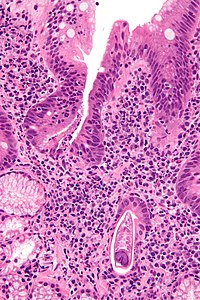
Photo from wikipedia
Background Strongyloides stercoralis causes chronic intestinal infection that may lead to disseminated disease during immunosuppression. Therefore, efficient diagnostic methods are essential to detect silent and latent infections. The present study… Click to show full abstract
Background Strongyloides stercoralis causes chronic intestinal infection that may lead to disseminated disease during immunosuppression. Therefore, efficient diagnostic methods are essential to detect silent and latent infections. The present study was aimed to compare the efficacy of parasitological methods for the detection of S. stercoralis infection. Methods A cross-sectional study was conducted on 351 subjects (226 HIV positive and 125 HIV negative) from October 2005 to May 2006. The study participants were selected by systematic random sampling method. Fresh fecal samples were collected from each participant and processed by different parasitological methods. Results Among the 351 individuals involved in the study, 43(12.3%) were infected by S. stercoralis. The prevalence of S. stercoralis infection was significantly higher among HIV positive subjects (17.3%) as compared with 3.2% in HIV negative subjects (p=0.001). The odd of being infected by S. stercoralis was significantly higher among AIDS patients (OR=6.31; 95% CI, 2.2–18.1) and HIV patients with diarrhea (OR=9.3; 95% CI 4.6–18.9) as compared with respective controls. Agar plate culture showed superior sensitivity (97.7%) than other methods for detection of S. stercoralis. Similarly, agar plate culture showed strong diagnostic agreement with Baermann's method (kappa = 0.82; 95% CI 0.72 – 0.92) followed by fecal concentration (kappa= 0.67; 95% CI=0.54–0.80). Coclusion This study revealed that HIV patients were about 6 folds susceptible for S. stercoralis infection. Similarly, agar plate culture showed superior diagnostic efficiency for detections of S. stercoralis infection.
Journal Title: Ethiopian Journal of Health Sciences
Year Published: 2017
Link to full text (if available)
Share on Social Media: Sign Up to like & get
recommendations!